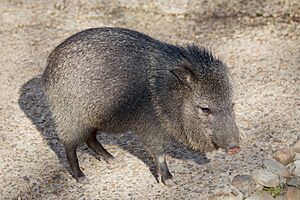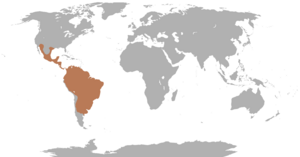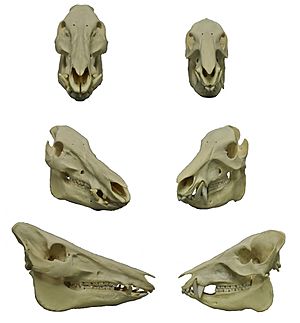Peccary facts for kids
Quick facts for kids Peccaries |
|
|---|---|
 |
|
| Collared peccary, Dicotyles tajacu | |
| Scientific classification |
|
| Kingdom: | Animalia |
| Phylum: | Chordata |
| Class: | Mammalia |
| Order: | Artiodactyla |
| Suborder: | Suina |
| Family: | Tayassuidae Palmer, 1897 |
| Type genus | |
| Tayassu Waldheim, 1814
|
|
| Extant and subfossil genera | |
|
|
 |
|
| Range of the peccaries | |
| Synonyms | |
|
Dicotylidae |
|
Peccaries are fascinating animals that look a lot like small pigs. People also call them javelinas or skunk pigs. They belong to a family called Tayassuidae. You can find them in Central and South America, on the island of Trinidad, and in the southwestern United States.
These animals are usually about 90 to 130 centimeters (3 to 4 feet) long. A grown-up peccary weighs around 20 to 40 kilograms (44 to 88 pounds). They are close relatives of true pigs, but they are a different family.
Peccaries love to live in groups called squadrons. A squadron usually has six to nine members. They are omnivores, meaning they eat both plants and small animals. They enjoy roots, insects, and many other foods. Peccaries use their strong smell to recognize each other. They can have babies throughout the year, usually two at a time.
Long ago, peccaries first lived in North America. They later moved to South America. Sometimes, people confuse peccaries with wild domestic pigs. Ancient people like the Maya kept peccaries for food and special ceremonies. Today, some people keep them as pets or raise them on farms.
Contents
What's in a Name? Understanding "Peccary"
The word "peccary" comes from an old Carib word, "pakira." This word was used by native people in the Caribbean.
In different countries, peccaries have many names. In Spanish, they are often called "javelina" or "pecarí." The word "javelina" comes from the Spanish word for "wild boar." In Portuguese, people might call them "pecari" or "porco-do-mato," which means "forest pig."
The scientific family name, Tayassuidae, also comes from a similar root. It helps scientists classify these unique animals.
Peccary Characteristics: What Makes Them Unique?
Peccaries are medium-sized animals. They look a lot like pigs, but they have some key differences. Like pigs, they have a flexible snout and small eyes. They walk on the two middle toes of each foot.
What Do Peccaries Eat?
Peccaries are omnivores, meaning they eat both plants and small animals. Their favorite foods include roots, grasses, seeds, fruits, and cacti. They also enjoy insects and grubs.
Peccary Teeth and Tusks
One of the easiest ways to tell a peccary from a pig is by looking at its teeth. Pigs have long, curved tusks. Peccaries have shorter, straight tusks that interlock. These special tusks help them crush hard seeds and cut through plant roots. They also use their tusks to defend themselves from predators. When they rub their tusks together, they make a chattering sound. This noise warns enemies to stay away.
How Peccaries Communicate
Peccaries are very social animals. They live in groups called herds or squadrons. Some white-lipped peccary herds can have over 100 members! Collared and Chacoan peccaries usually live in smaller groups. Living together helps them protect their territory, stay safe from predators, and keep warm.
Peccaries have special scent glands under their eyes and on their backs. They use these glands to mark their territory. They also rub against each other to share their scent. This strong smell helps peccaries recognize their family members. Their eyesight isn't very good, so smell is super important! Humans can even smell it, which is why some people call them "skunk pigs."

Peccary Species Around the World
Today, there are three main types of peccaries. They live across a wide area, from the southwestern United States down to South America and Trinidad. Each type belongs to its own special group, or genus.
The Collared Peccary
The Collared peccary (Dicotyles tajacu) is also called a "musk hog" because of its strong scent. It lives in many places, from the dry scrublands of the southwestern U.S. to the wet rainforests of South America. They have rough, dark hair with a lighter "collar" around their shoulders.
Collared peccaries can have babies all year. They usually have two or three young at a time. They are good at living near people, even in cities and on farms. In places like Arizona, they are often called "javelinas." These peccaries usually live in groups of 8 to 15 animals. They generally avoid humans but will defend themselves if they feel threatened.
The White-Lipped Peccary
The White-lipped peccary (Tayassu pecari) mostly lives in the rainforests of Central and South America. You can also find them in other places like dry forests and grasslands. Sadly, these peccaries face challenges. Losing their forest homes and hunting are big threats to their survival.
The Chacoan Peccary
The Chacoan peccary (Catagonus wagneri) lives in the dry shrublands of Paraguay, Bolivia, and Argentina. This species has an interesting story! Scientists first knew about it from old fossils. They thought it was extinct. But in 1975, people discovered living Chacoan peccaries in Paraguay! Local people had known about them all along.
The Giant Peccary: A Mystery
There might be a fourth species called the giant peccary (Dicotyles maximus). A biologist named Marc van Roosmalen described it in the Brazilian Amazon. Local people knew it as "caitetu munde," meaning "great peccary that lives in pairs." It was thought to be the largest peccary, growing up to 1.2 meters (4 feet) long. Unlike other peccaries, it seemed to live in pairs. However, scientists later questioned if it was truly a separate species. Today, many consider it to be the same as the collared peccary.
Extinct Peccaries
Long ago, during the Late Pleistocene period, two types of peccaries called Mylohyus and Platygonus lived across North and South America. They disappeared about 12,000 years ago.
Peccaries Through Time: Evolution
Peccaries have a long history! The oldest clear fossils of peccaries come from North America. This was during a time called the Early Miocene epoch.
About three million years ago, a land bridge formed between North and South America. This event is known as the Great American Interchange. Many animals, including peccaries, llamas, and tapirs, moved from North America to South America. Some South American animals, like ground sloths, also moved north.
Today, most peccary species live in warmer, tropical areas. However, the collared peccary still lives in northern Mexico and the southwestern United States.
Peccaries and People
Peccaries have been part of human history for a long time. They look like pigs because they share a common ancestor. People in Brazil first described peccaries scientifically in 1547, calling them "wild pigs."
Ancient civilizations, like the Maya, kept peccaries. They raised them for food and used them in special ceremonies. Scientists have found peccary remains at ancient sites in Central America.
It can be tricky to raise peccaries on modern farms. They take longer to have babies and sometimes harm their young.
Peccaries and Wild Pigs
In some areas, peccaries live alongside wild domestic pigs. These wild pigs are sometimes called "razorback" hogs. Scientists are still studying how these two groups interact. It's possible that jaguars, which hunt peccaries, might sometimes hunt wild pigs instead. This could help peccary populations.
Interesting facts about Peccaries
- Peccaries belong to a family called Tayassuidae, which means they are "New World pigs."
- Scientists recognize three, and possibly even four, living species of peccaries. They each have their own genus (a scientific grouping) and live in different parts of the Americas.
- Size: 90-130 cm (length), 20-40 kg (weight).
- Diet: Omnivore (eat plants and small animals).
- Social Structure: They live in herds called "squadrons".
- For their strong odor some people call them "skunk pigs"!
See also
 In Spanish: Tayasuido para niños
In Spanish: Tayasuido para niños

